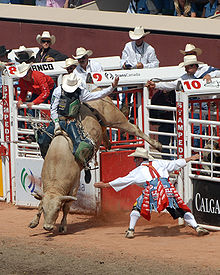Bucking bull



A bucking bull is a bull used in rodeo bull riding competition. They are usually a Brahman crossed with another breed, weighing 1,500 pounds or more, selected for their tendency to "leap, plunge and spin" when a human is on its back.[1] Circa mid-20th century breeders began selecting bulls for bad temperament, that would buck when ridden.[2] Many of the best bucking bulls trace their lineage to bulls owned by Charlie Plummer of Oklahoma. These are known as Plummer bulls.[3]
Bucking bulls are viewed as athletes. They usually are started in their bucking career at the age of two or three, reach their athletic prime at age five or six, and if they remain healthy, can continue bucking at least until the age of 10, sometimes longer.[4]
In some competitions between bulls, with a purse amounting to tens of thousands of dollars per event, the bulls are ridden by electronic dummies, not rodeo bull riders.[5] Good performing bulls attain a celebrity status and can be considered a star athlete in their own right, and a valiant competitor on the field against the human rider.[6][7]
The first sale of breeding cows out of champion bucking bulls was in 1999.[8]
From a veterinary medicine perspective, bucking bulls see diagnoses that are different from regular cattle.[9] This may be due to their role being similar to an athlete.
The percent of top professional riders staying on the bull for a full eight second "out" had dropped from 75% in the early 1990s to 35% circa 2014. This has led to criticism that the breeding has resulted in excessively aggressive and dangerous animals.[10]
Some notable bucking bulls include Bodacious, Bruiser, Bushwacker, Chicken on a Chain, Dillinger, Little Yellow Jacket and Pacific Bell. A bull named Panhandle Slim had four clones, with identical bucking patterns, who like their sire, competed in the Professional Bull Riders circuit.[11][12]
See also
[edit]- American Bucking Bull
- Mechanical bull
- Stock contractor
- Rodeo clown
- Pickup rider
- Steer riding
- Bucking horse
References
[edit]- ^ Curnutt 2001, p. 268.
- ^ Nance 2013, p. 181.
- ^ Groves 2006, p. 14.
- ^ "2016 PBR Media Guide", "Bulls", pp .199-212.
- ^ Kevin Kerr (April 25, 2011), "The gold standard", Duncan Banner
- ^ Lawrence 1984, p. 197.
- ^ Nance 2013, pp. 174–177, "Animal celebrity defined".
- ^ Lynn Montgomery (April 15, 2004). "Bucking bull breeders bring their best to competition". Country World Archives 2001-2008. Country World. Archived from the original on December 20, 2016.
- ^ Smith, Joe S.; Angelos, John A.; Chigerwe, Munashe (June 1, 2017). "Disorders of performance-age bucking bulls". Journal of the American Veterinary Medical Association. 250 (11): 1302–1307. doi:10.2460/javma.250.11.1302. ISSN 0003-1488.
- ^ Andrea Appleton (July 8, 2014), "Too Much Bull: An Industry Obsessed with Breeding Bigger, Nastier Bulls Is Putting Children In Harm's Way. One Champion Rider is Fighting to Change That.", SB Nation, Vox Media
- ^ Lisa M. Krieger (July 16, 2013), "Rodeo bulls better bred through science to buck riders", San Jose Mercury News
- ^ Dylan Brown (June 30, 2013), "'Long dead' bull lives on in clones: Practice grows on rodeo circuit", Lewiston Tribune – via Spokane Spokesman-Review
Bibliography
[edit]- Nance, Susan (2013), "A Star is Born to Buck: Animal celebrity and the marketing of professional rodeo", in James Gillett; Michelle Gilbert (eds.), Sport, Animals, and Society, Routledge, ISBN 9781135019150
- Groves, Melody (2006), "Stock contractors and animals", Ropes, Reins, and Rawhide: All about Rodeo, UNM Press, ISBN 9780826338228
- Lawrence, Elizabeth Atwood (1984), "The role of cattle in rodeo", Rodeo: An Anthropologist Looks at the Wild and the Tame, University of Chicago Press, ISBN 9780226469553
- Curnutt, Jordan (2001), "Animal entertainment: Rodeo", Animals and the Law: A Sourcebook, ABC-Clio, ISBN 9781576071472
Sources
[edit]- 2016 PBR Media Guide (PDF). Professional Bull Riders. 2016. Archived from the original (PDF) on August 13, 2018. Retrieved June 4, 2019.